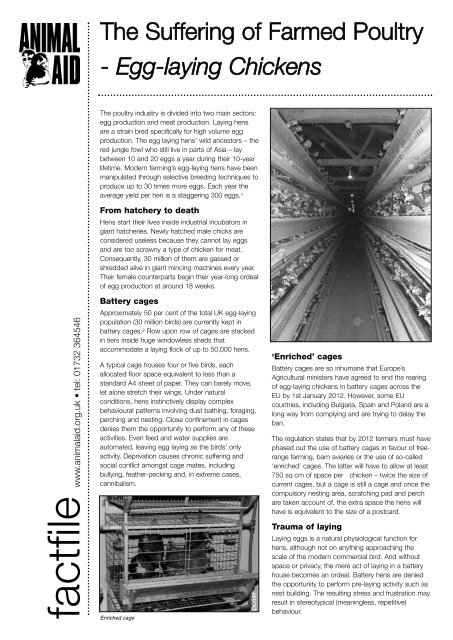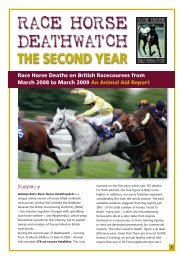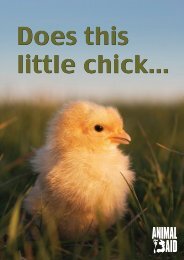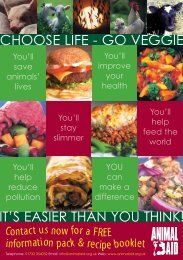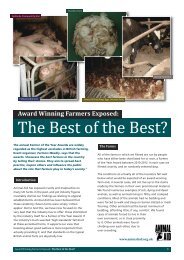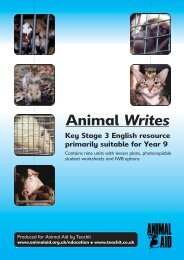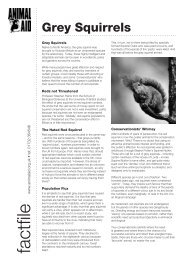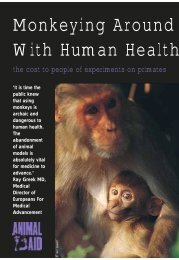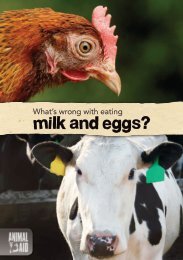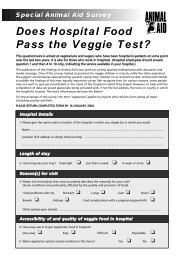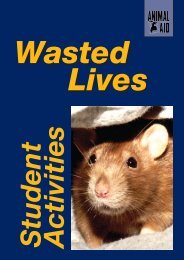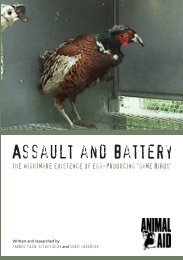The Suffering of Egg-Laying Chickens - Animal Aid
The Suffering of Egg-Laying Chickens - Animal Aid
The Suffering of Egg-Laying Chickens - Animal Aid
Create successful ePaper yourself
Turn your PDF publications into a flip-book with our unique Google optimized e-Paper software.
<strong>The</strong> <strong>Suffering</strong> <strong>of</strong> Farmed Poultry<br />
- <strong>Egg</strong>-laying <strong>Chickens</strong><br />
<strong>The</strong> poultry industry is divided into two main sectors:<br />
egg production and meat production. <strong>Laying</strong> hens<br />
are a strain bred specifically for high volume egg<br />
production. <strong>The</strong> egg laying hens’ wild ancestors – the<br />
red jungle fowl who still live in parts <strong>of</strong> Asia – lay<br />
between 10 and 20 eggs a year during their 10-year<br />
lifetime. Modern farming’s egg-laying hens have been<br />
manipulated through selective breeding techniques to<br />
produce up to 30 times more eggs. Each year the<br />
average yield per hen is a staggering 300 eggs. 1<br />
From hatchery to death<br />
Hens start their lives inside industrial incubators in<br />
giant hatcheries. Newly hatched male chicks are<br />
considered useless because they cannot lay eggs<br />
and are too scrawny a type <strong>of</strong> chicken for meat.<br />
Consequently, 30 million <strong>of</strong> them are gassed or<br />
shredded alive in giant mincing machines every year.<br />
<strong>The</strong>ir female counterparts begin their year-long ordeal<br />
<strong>of</strong> egg production at around 18 weeks.<br />
• tel: 01732 364546<br />
factfile www.animalaid.org.uk<br />
Battery cages<br />
Approximately 50 per cent <strong>of</strong> the total UK egg-laying<br />
population (30 million birds) are currently kept in<br />
battery cages. 2 Row upon row <strong>of</strong> cages are stacked<br />
in tiers inside huge windowless sheds that<br />
accommodate a laying flock <strong>of</strong> up to 50,000 hens.<br />
A typical cage houses four or five birds, each<br />
allocated floor space equivalent to less than a<br />
standard A4 sheet <strong>of</strong> paper. <strong>The</strong>y can barely move,<br />
let alone stretch their wings. Under natural<br />
conditions, hens instinctively display complex<br />
behavioural patterns involving dust bathing, foraging,<br />
perching and nesting. Close confinement in cages<br />
denies them the opportunity to perform any <strong>of</strong> these<br />
activities. Even feed and water supplies are<br />
automated, leaving egg laying as the birds’ only<br />
activity. Deprivation causes chronic suffering and<br />
social conflict amongst cage mates, including<br />
bullying, feather-pecking and, in extreme cases,<br />
cannibalism.<br />
Enriched cage<br />
©CIWF<br />
‘Enriched’ cages<br />
Battery cages are so inhumane that Europe’s<br />
Agricultural ministers have agreed to end the rearing<br />
<strong>of</strong> egg-laying chickens in battery cages across the<br />
EU by 1st January 2012. However, some EU<br />
countries, including Bulgaria, Spain and Poland are a<br />
long way from complying and are trying to delay the<br />
ban.<br />
<strong>The</strong> regulation states that by 2012 farmers must have<br />
phased out the use <strong>of</strong> battery cages in favour <strong>of</strong> freerange<br />
farming, barn aviaries or the use <strong>of</strong> so-called<br />
‘enriched’ cages. <strong>The</strong> latter will have to allow at least<br />
750 sq cm <strong>of</strong> space per chicken – twice the size <strong>of</strong><br />
current cages, but a cage is still a cage and once the<br />
compulsory nesting area, scratching pad and perch<br />
are taken account <strong>of</strong>, the extra space the hens will<br />
have is equivalent to the size <strong>of</strong> a postcard.<br />
Trauma <strong>of</strong> laying<br />
<strong>Laying</strong> eggs is a natural physiological function for<br />
hens, although not on anything approaching the<br />
scale <strong>of</strong> the modern commercial bird. And without<br />
space or privacy, the mere act <strong>of</strong> laying in a battery<br />
house becomes an ordeal. Battery hens are denied<br />
the opportunity to perform pre-laying activity such as<br />
nest building. <strong>The</strong> resulting stress and frustration may<br />
result in stereotypical (meaningless, repetitive)<br />
behaviour.
• tel: 01732 364546<br />
factfile www.animalaid.org.uk<br />
De-beaking<br />
<strong>The</strong> egg industry attempts to prevent the stressed<br />
birds from harming one another by amputating the<br />
upper part <strong>of</strong> the beak in a routine mutilation known<br />
as de-beaking or beak-trimming. Up to half <strong>of</strong> the<br />
upper and sometimes also the lower part <strong>of</strong> the beak<br />
is sliced <strong>of</strong>f using a red-hot blade when the hens are<br />
chicks. This causes chronic pain and further hampers<br />
any attempt at natural behaviour. This practice is<br />
prohibited only under organic standards.<br />
Free-range and organic birds<br />
<strong>The</strong> term ‘free-range’ suggests a handful <strong>of</strong> chickens<br />
scratching around a yard. But modern units usually<br />
contain thousands <strong>of</strong> selectively-bred birds packed<br />
together in sheds. Pop holes allow the inhabitants to<br />
exit and re-enter when the weather is suitable –<br />
providing they can struggle through the crowds <strong>of</strong><br />
birds blocking the holes. But because <strong>of</strong> the special<br />
stresses associated with such intensive ‘free-range’<br />
systems (the struggle for territory; the movement<br />
from the heated interior to the bug-laden outside<br />
world and back again; and the fact that they are the<br />
same highly in-bred strains as those raised in the<br />
most intensive systems), the birds typically suffer a<br />
premature mortality rate <strong>of</strong> four per cent. 3 This<br />
compares with five per cent for standard intensive<br />
systems. 4<br />
<strong>The</strong> label ‘organic’ also implies higher welfare<br />
standards but it comes with no guarantee that the<br />
animals lived free-range. While organic and freerange<br />
animals are likely to have had a better quality<br />
<strong>of</strong> life than more intensively reared birds, they can still<br />
be housed in groups <strong>of</strong> up to 3,000 and, under<br />
organic standards, must be provided with outside<br />
access for only a third <strong>of</strong> their lives. Whether freerange,<br />
organic or factory farmed, the birds will be<br />
subjected to the same trauma <strong>of</strong> transport to the<br />
killing factory and the same terrifying, bloody death.<br />
Sickness<br />
Physical consequences <strong>of</strong> confinement include foot<br />
deformities – caused mainly by the absence <strong>of</strong><br />
suitable perches – and severe bone weakness. This<br />
is prompted by restrictions on movement and, thus,<br />
normal skeletal development.<br />
As a consequence, battery hens are prone to multiple<br />
fractures during capture and transportation to the<br />
killing plant. Bone weakness is exacerbated by<br />
calcium deficiencies, which can lead to<br />
osteoporosis. 5 <strong>The</strong> creation <strong>of</strong> hundreds <strong>of</strong> egg shells<br />
requires a lot <strong>of</strong> calcium, and this is leached from the<br />
birds’ bones. 6 More than 45 per cent <strong>of</strong> laying hens<br />
break a bone at some point during their lives. 7<br />
References<br />
1) Defra, 2009. Agriculture in the UK.<br />
2) British <strong>Egg</strong> Information Service, 2011. <strong>Egg</strong> production.<br />
www.britegg.co.uk.<br />
3) M. Samuel, Feb, 2008. 1,726,400,000 free-range birds? <strong>The</strong> Times, 29 Feb.<br />
4) RSPCA, 2001. Behind closed doors.<br />
5) M. Gentle, 2002. Comparative vertebrate nociception and pain. Roslin Institute,<br />
Scotland, 3 Dec.<br />
6) T.G. Knowles and L.J. Wilkins, 1998. <strong>The</strong> problem <strong>of</strong> broken bones during the<br />
handling <strong>of</strong> laying hens—A review. Poultry Science, 77 p.1798-1802.<br />
Free-range unit<br />
Slaughter<br />
<strong>Chickens</strong> naturally live for up to 10 years but, at 72<br />
weeks old, egg-laying hens are no longer able to<br />
produce the amount <strong>of</strong> eggs required and so can be<br />
worth as little as two pence. <strong>The</strong> worn-out bodies <strong>of</strong><br />
these birds, known as ‘spent hens’, go into cheap<br />
meat products, such as soups, pies and pet food.<br />
Even their ‘by-products’ (including gizzards, entrails,<br />
hearts and other organs 8 ) are turned into an<br />
‘emulsion’, from which burgers and other processed<br />
foods can be made. 9 Because their value is so low,<br />
few slaughterhouses will take these hens, and so<br />
millions are subjected to even longer than usual<br />
transportation times to killing factories. 10<br />
Poultry slaughter methods are highly mechanised and<br />
designed to maximise speed rather than to minimise<br />
suffering. <strong>Chickens</strong> are removed from their crates and<br />
suspended upside down by their legs on metal<br />
shackles. <strong>The</strong> most common method <strong>of</strong> slaughter is<br />
for a conveyer to take the birds' heads through an<br />
electrically charged water bath, with the current<br />
designed to stun and leave them insensible to pain<br />
when their throats are cut. <strong>The</strong>y are killed by an<br />
automatic knife, which severs the main blood vessels<br />
in the neck. A slaughterer is also present to slit the<br />
throats manually <strong>of</strong> any birds missed by the machine.<br />
Once dead, the birds are immersed in a scalding<br />
tank to loosen their feathers before plucking.<br />
<strong>The</strong>re is considerable evidence that the slaughter<br />
process is inefficient. Inadequate stunning results in<br />
some birds going to the knife and even to the<br />
scalding tank alive.<br />
7) A. B. Webster, 2004. Welfare implications <strong>of</strong> avian osteoporosis. Poultry<br />
Science 83 p.184-192.<br />
8) Dictionary <strong>of</strong> Food Science & Technology.<br />
9) Kala, K. Rajani et al, 2007. Evaluation <strong>of</strong> quality <strong>of</strong> chicken emulsions stored<br />
refrigerated (4±1°C) for chicken patties. International Journal <strong>of</strong> Food Science &<br />
Technology, 42, No. 7, p.842-851.<br />
10) Farm <strong>Animal</strong> Welfare Council, 2002. Proceedings <strong>of</strong> the Farm <strong>Animal</strong> Welfare<br />
Council’s open meeting held on 27 June.<br />
Updated July 2011


